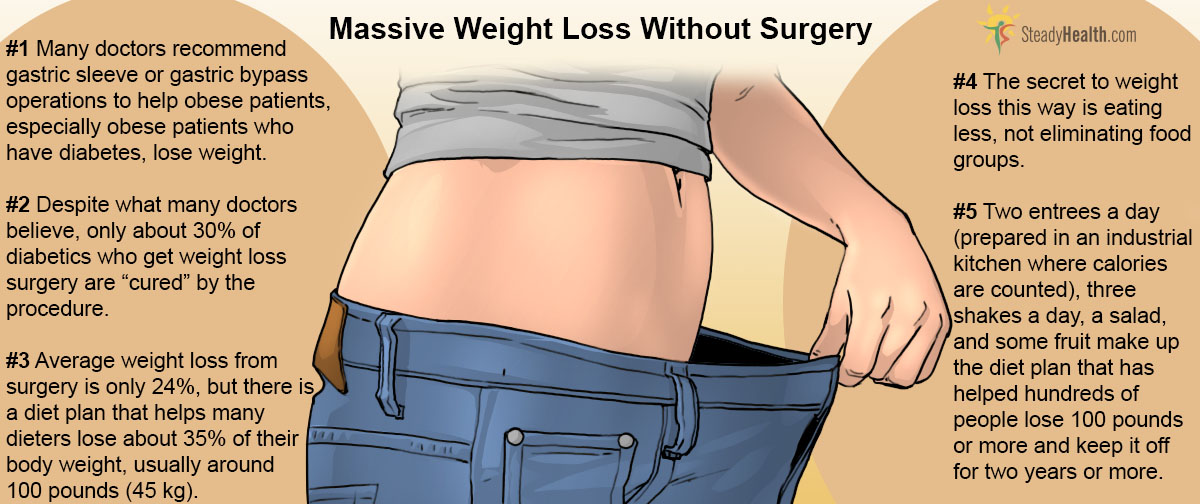Many American doctors have a very positive opinion of gastric bypass and lap band surgery, especially for their diabetic patients.
Doctors recommend these stomach-reducing procedures to their patients who suffer morbid obesity, usually needing to lose 100 pounds (45 kilos) or more, especially those who have not been able to get their blood sugar levels under control after trying for a year. Gastric bypass is also sometimes recommended as a treatment for moderately overweight diabetics who are unable to control their blood sugars with exercise, diet, medication, and insulin.
Less Expensive, No More Dangerous Than Other Options
Promoters of the procedure tout the $15,000 to $25,000 procedure as a nearly immediate "cure" for type 2 diabetes, and recommend it for women who have polycystic ovarian diseases and for people of both sexes who have joint problems aggravated by weight and cardiovascular disease.
The cost of the procedure may sound high, but it is usually covered by insurance for people who are morbidly obese (who have a BMI over 40), and it is no more expensive than a typical year's medical expenses for many people who have uncontrolled diabetes.
Surgeons usually perform gastric bypass through "keyhole" surgery. They make a very small incision and use special instruments to transform the stomach into a tiny pouch which they reconnect to the small intestine. (Sleeve gastrectomy, another common procedure, results in a less drastic reduction in the size of the stomach.) Complications occur in about 1 percent of cases, but the overall risk of hospitalization and death is no higher for patients who get this kind of bypass than for those who do not.
Does Gastric Bypass Deliver What It Promises?
As a treatment for diabetes, gastric bypass is considerably less than 100 percent effective. In a clinical trial reported in 2014, 38 percent of type 2 diabetics receiving the procedure in one group and 25 percent of type 2 diabetics receiving the procedure in another group went into "full remission" from diabetes.
At the beginning of the study, 90 percent of patients needed insulin, but three years later, only 50 percent continued to need to take daily insulin injections. And diabetics receiving the procedure lost, on average, 23 percent of their body weight and kept if off.
Diabetics who took medications were on average able to get their HbA1C levels (a measurement of long-term blood sugar control) down to a still unacceptably high 8.4 percent, while diabetics who got weight loss surgery were able to get their levels down to a still-high but acceptable 6.7 to 7.0 percent.
A New Stomach, A New Life
What doctors usually don't tell their gastric bypass surgery patients is that a new stomach may require a new life. Husbands and wives of newly thinner spouses may be threatened by their newfound positive attitudes and attractiveness.
See Also: Psychology Of Weight Loss: Willpower Has Limits
Food no longer plays the same role in life after a gastric bypass. It's no longer possible to drown your sorrows in a carton of Haagen-Dasz ice cream or celebrate a holiday with hot dogs and roasted Marshmallows. Holiday meals have to be rethought, and gatherings with family and friends can no longer center around food — or the person who gets the bypass must be able to deal with being left out.
Prepackaged Meals For Massive Weight Loss
Dr James W Anderson, a professor of medicine at clinical nutrition at the University of Kentucky, recorded some astonishing results of a dietary intervention for morbid obesity in 2007. Anderson and his colleagues began their weight loss program with 12 weeks of intensive instruction in eating to support a leaner body. Of the 1100 people who at least completed the classroom phase of the diet:
- Dieters began with an average weight of 308.2 pounds (139.8 kg).
- Dieters lost an average of 77.8 pounds (35.3 kg).
- Dieters still were an average of 50 pounds (22.7 kg) lighter 2-1/2 years later.

Those were the results from just knowing how to eat better. Of the original group, 268 people stuck to the plan closely enough to lose 100 pounds (45.4 kg) or more. In this group:
- The average starting weight was 349.2 pounds (158.4 kg).
- The average ending weight was 211.8 pounds (96.1 kg), for an average weight loss of 137.4 pounds (60.3 kg). Most dieters took 50-55 weeks to lose this much weight.
- The average weight loss maintained 2 years later was 90.4 pounds (41 kg). Dieters gained about 1/3 of the weight back but not all of it.
Anderson's diet combines a number of the best features of less successful but still familiar diets. Some doctors put their patients on liquid diets.
- Anderson's diet involves 3 prepared meal replacement shakes per day, but is not an entirely liquid diet.
- Some diets rely on prepared meals for calorie reduction. Anderson's dieters ate two prepared entrees per day.
- Diets are difficult to maintain because they become boring. Anderson's dieters were allowed to choose salad vegetables and fruit to complement their prepared entrees, giving them variety and control over colors, textures, and flavors, and adding essential nutrients not just for the human body but for probiotic bacteria that live in the gut.
The cost of three shakes or soups and two entrees is about $17 a day, less than the cost of a single meal for many people who are addicted to food. Anderson guided the formulation and production of Health Management Resources products, available online, but using any similar products should yield similar results.
What do you need to know for success on the 100-pound non-surgical diet plan?
- If you live with someone else, they have to be on board with your weight loss. You don't have a gastric bypass to stop you from eating, and you need to have an understanding with your spouse, significant other, or roommate that offering you food does not help you reach your goal weight.
- If you feel hungry, eat more salad. Eat more fruit (but don't go over 3 pieces of fruit a day, too much fructose causes its own problems). Eat another prepared entree. But don't go out for burritos, burgers, beef steaks, or buttered popcorn. Resolve that the only food you will eat is the food you eat on your program, and keep track, in writing, of everything you eat every day.
- Don't be discouraged if you plateau, that is, if your weight loss decreases after a few weeks or a few months. Your new you needs fewer calories, so you the more weight you lose, the fewer caloires you need, and the more slowly you will continue to lose weight. This is the time to resolve to stay on your diet and enjoy the extra energy you already feel, to get out and do more.
- Don't expect to be on your diet for less than a year. And even when you have reached your goal weight, weigh yourself at least once or twice a week. Go back on your diet plan as soon as you see weight beginning to come back.
See Also: Are Weight Loss Products Beneficial?
The changes in your health may not begin to show up for a few weeks, but there will be changes, and the money you no longer spend on food can be spent on having a good life.
- Maggard MA, Shugarman LR, Suttorp M, Maglione M, Sugerman HJ, Livingston EH, Nguyen NT, Li Z, Mojica WA, Hilton L, Rhodes S, Morton SC, Shekelle PG.Meta-analysis: surgical treatment of obesity. Ann Intern Med. 2005 Apr 5
- 142(7).547-59.
- Mind map by SteadyHealth.com
- Photo courtesy of Butz.2013 via Flickr: www.flickr.com/photos/61508583@N02/14419832406



Your thoughts on this